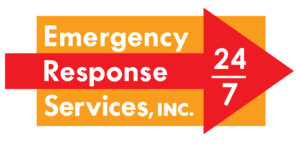
Winter in Michigan is no laughing matter! This season, more than ever before, insurance agents are reporting issues from ice damming. If you’ve yet to experience this problem, now is the time to take action to prevent ice dams and the need for water damage restoration services.
What is an Ice Dam?
What Causes Ice Dams?
Several factors combine to cause ice dams. These include heat loss from the property, snow, and freezing temperatures. Ice dams occur when there is snow on the roof, yet the roof’s exterior is above 32 degrees F, while the lower, interior surfaces are below 32 degrees.
Because the roof surface is above freezing, the snow melts back to liquid water. This water travels down the roof, arriving at sections that are below 32 degrees. This water then freezes, creating an ice dam.
As more snow melts above, the ice dam continues to grow. Due to the back up, the water will remain liquid, penetrating cracks and other vulnerabilities in the roof and attic. You can imagine that from the attic, the water continues to flow, down to the ceiling and beyond. At this point, you have a serious water loss on your hands.
How Do Ice Dams Form?
There are a few steps that occur in the formation of ice dams. Here is how ice dams form:
- Heat gathers around the attic, warming the roof but not its eaves.
- Snow on the roof melts and freezes at the eaves.
- Ice builds up at the eaves, creating an ice dam.
- Meltwater backs up behind the ice, seeping through shingles and into the home.
Why Are Ice Dams Bad?
On top of the potential damage to your roof, water damage introduces a host of other problems. Once moisture permeates your home, you run the risk of secondary damages such as structural collapse, as well as mildew and mold growth. Mold can have negative long-term effects.
Moreover, ice dams are a serious threat to the exterior of the home. Ice dams can rip off gutters, dislodge shingles, and contribute to water damage. Once this damage is inside the home, you will face sagging ceilings and walls, peeling paint, warping of floors, stains, soggy insulation, and more.

How to Prevent Ice Dams
As bad as ice dams are, there several measures you can take to prevent them. Here is how to prevent ice dams this winter:
1. Prevention is Key
Before ice dams build up, take pictures where you see frosty evidence. This can be used to narrow down an interior inspection to check for leaks.
2. Install Heated Cables
Heated cables attach to the edge of the roof and work to prevent ice dams. These helpful cables regulate the temperature of the roof, supplying heat from the outside. Of course, you’ll need to install heated cables before any winter weather.
3. Ventilate the Roof’s Eaves and Ridges
Ensure that the ridge and any vents have uniform size openings that allow for a minimum of 1 square foot opening for every 300 square feet of attic. Install baffles at eaves to keep airflow moving from vents.
4. Seal the Attic Hatch
Cover the attic hatch with a weatherstripping cap made of foil-faced foam board. Secure the cap with aluminum tape.
5. Ventilation
Check to see that ducts from the kitchen, bathroom, and dryer are pointed outdoors through the roof or walls. These should never be directed through the soffit.
6. Insulate, Insulate, Insulate
Increasing the insulation of the attic floor will trap heat there, preventing ice dams.
7. Consider Your Lighting
Recessed lighting can give off heat that prevents ice dams without generating a fire concern. You can replace these with “IC” fixtures covered in insulation.
8. Check the Flashing
Gaps between the chimney and rest of the house should be sealed with steel flashing. These are fastened securely by a fire-stop sealant. Avoid canned spray foam and insulation.
9. Don Your Ducts
10. Caulk the Seams
Areas around electric cables and ventilation pipes should be caulked with a fire-stop sealant. Be sure to caulk areas where you can see light shining through, or where you see stained insulation where air has passed.
How to Get Rid of Ice Dams
Unfortunately, ice dams often catch Michigan homeowners off guard. Even still, there are a tips on how to get rid of ice dams.
1. Be Careful!
Never attempt to hack at ice dams with shovels, hammers, chisels, or any other tool. This can damage your roof and be hazardous to you.
2. Use Cold Air
We know! – it sounds counterproductive, but it works. Head up to your attic with a box fan. Point the fan at the underside of the roof where water is leaking through. The cold air will freeze the water, effectively stopping the leak.
3. Use a Rake
With an aluminum roof rake, you can change the temperature of the exterior of the roof from the safety of the ground. By using a roof rake, you can have peace of mind that further damage to the shingles will not be an issue.
4. De-ice
If all else fails, head to the sock drawer for a pair of panty hose. If you fill them with an ice melter of a calcium chloride base and lay it over the ice dam, it will eventually melt the snow and ice. This will allow for a path for the water to reach the gutters.
Call ERSI for Water Damage Due to Ice Dams
If worse comes to worst, Emergency Response Services, Inc. Is here to help. We offer 24/7 water extraction services, water damage cleanup, water damage restoration, and water damage repairs. Call us at 877-JOB-DONE.

